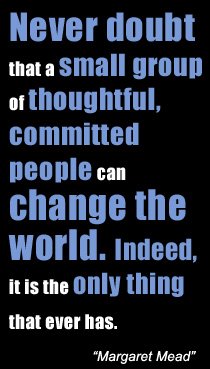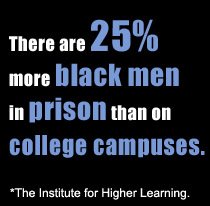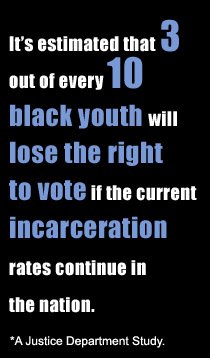GodSta - Put it down. Follow me.
GodSta is a counter-revolution of ideas, principles and systems for those who are willing to create change. Our weapons are love, peace, and hope. Our colors are bright and illuminating for the purpose shedding light on issues that need to be faced and addressed. Our initiation is a commitment to fight the good fight of faith. We Know who the enemy is and how to address him.
Monday, March 01, 2010
Friday, February 19, 2010
Black Farmers, USDA Agree to $1.25 Billion Settlement
By LAUREN ETTER
A group of black farmers reached a $1.25 billion settlement with the U.S. Department of Agriculture over a longstanding civil-rights case that had cast a pall over the agency for decades.
In a conference call Thursday, Secretary of Agriculture Tom Vilsack said the settlement would close a "sordid chapter in USDA history."
"This is a very historic, emotional day for black farmers," said John Boyd Jr., president of the National Black Farmers Association who once traveled 200 miles in a mule-drawn wagon from Baskerville, Va., to Washington to raise awareness about black farmers. "But the [Obama] administration is going to have to help me finish the job."
Thursday's settlement, which remains contingent on the money being appropriated by Congress, stems from a 1997 class-action civil-rights lawsuit, Pigford v. Glickman, that was filed by three African-American farmers alleging the USDA had discriminated against them and other black farmers.
Among other things, the farmers claimed they were systematically denied USDA loans and farm subsidies by agency officers. Some farmers said that, even if they were awarded a loan, the agency took so long to allot it that time ran out to plant that season's crop and they were unable to repay other debts.
The Pigford case, which was filed in U.S. District Court for the District of Columbia, was settled in April 1999. Just over $1 billion was awarded to about 16,000 claimants.
The case was reopened after black farmers argued that thousands of additional farmers hadn't been given the opportunity to make claims. The 2008 Farm Bill included a provision that restored those farmers' access to settlement awards.
It isn't clear how many farmers could qualify for the payout, but it could be tens of thousands. Last year, President Barack Obama inserted a $1.15 billion request in his budget proposal to Congress. Lawmakers didn't appropriate the money then because no formal settlement was in place, said Thomas Perrelli, U.S. associate attorney general. "I don't think anybody in Congress doubts" the funds will be appropriated "expeditiously," he said.
Mr. Obama said in a statement released Thursday, "I look forward to a swift resolution to this issue, so that the families affected can move on with their lives."
The settlement is the latest in the Obama administration's push to focus on civil-rights issues and close out longstanding discrimination claims. In December, the administration proposed spending $3.4 billion to settle longstanding claims that the federal government mismanaged Americans Indians' trust funds.
Write to Lauren Etter at lauren.etter@wsj.com
Monday, December 21, 2009
Completing the college years
TOO OFTEN, colleges and universities have blamed the poor performance of low-income and minority students on the preparation they received in high schools. Basically, their message was: Send us better students, and we'll show better results.
So it's nothing sort of a breakthrough that leaders of half the country's public colleges have embarked on an initiative to close racial and socioeconomic gaps in enrollment and graduation. Data from the Access to Success Initiative released this month paint a gloomy picture of low-income and minority students: Far too few enroll in college, and even fewer make it to graduation. Consider, for example, that 45 percent of low-income and minority students entering as freshmen in 1999 had received bachelor's degrees six years later, compared with 57 percent of other students.
Saturday, December 12, 2009
“Everybody Fine” - A movie for fathers to see.
With a 70% out-of-wedlock birth rate, we as Blackmen need as many inspirational references as possible. And believe it or not I recently found one in new feature film. There's very little fluff to this film. In essence, it's realistic, raw, touching and powerful, and transcends race and other significant differences. Its impact will be felt whether you're a parent or not. "Everybody's Fine "is a compelling story about a fathers relationship with his now adult children after his wife's passing.
At a recent NYC screening (for film critics) there wasn't a dry eye in the theater.
Checkout an interview with Kirk Jones the films director on Lingk2us.com. Enjoy!
Sunday, October 04, 2009
Price of Life
Witness the transformation of an ex-convict into a community leader. From life as a hustler to life as a responsible father, Robert Childs walks us through the realities of the “Price of Life.” Childs is the voice of ex-offenders who give up life on the street to repay their debt to their children and to society.
The Villanova University production Price of Life is a short documentary shot entirely on the streets of Philadelphia, PA. Produced in conjunction with the National Comprehensive Center for Fathers, Price of Life is a film on social justice; the lifestyles of urban street hustlers is chronicled through a series of interviews detailing paths to rehabilitation within the Philadelphia community.
Price of Life focuses on the life of Robert Childs, a Philadelphia native bred into the street culture of gun violence and drug trafficking from a young age. The film brings Childs back to the locations of some of the most notable events of his life, as he discusses the intricate details of street life during the two decades that he terrorized the streets of his local community.
From a young age, a life on the streets is the only way of life that Childs knew; without a father figure to turn to for guidance, Childs learned life lessons from older groups of hustlers who took him in. Price of Life reveals the lavish vices that Childs turned to in his darkest times, motivated purely by greed and a sense of maximizing all pleasures. There existed no clearly identifiable goal for Childs; each day was likely to be his last, as he watched his companions die around him throughout the years.
His debilitating journey of crime was littered with drawbacks stemming from conflicts with law enforcement and the constant threat of death. With no sense of death or morality, Childs’ reign as a horrifying figure of violence is shown in graphic detail to the audience of Price of Life, bringing a level of understanding to Childs’ life of darkened glamour.
Other figures in Price of Life include Childs’ mother Barbara Boyd, who recounts how Childs lived as an energetic youngster in the Philadelphia community. Her recollections of Childs’ youth bridge the gap between normal childhood behavior and his introduction to the violent culture that Childs came to dominate later in life. The most turbulent years of Childs’ life is recounted by his mentor Muhammad Shakur, who connects Childs’ experiences to the greater urban community as a whole. Shakur’s testimony brings to light the bigger issues within Price of Life, establishing the trends of violence that many fatherless figures of the black community turn to.
Childs’ path of rehabilitation through the National Comprehensive Center for Fathers (NCCF) served as the catalyst for turning his life around. Through a series of classroom instructions and personal mentoring, Childs worked to overcome the personal demons that plagued him for decades. Price of Life includes the NCCF’s director Kofi Asante, who provides his insight into Childs’ transformation and his strength and resolve to turn his life around to become a leader and role model for the community he once intimidated.
Monday, August 17, 2009
Tom Daley, Dancing With The Stars?
I thought he was in jail with Jack Abramoff.
The DeLay-Abramoff Money Trail
Nonprofit Group Linked to Lawmaker
Was Funded Mostly by Clients of Lobbyist
By R. Jeffrey Smith
Washington Post Staff Writer
Saturday, December 31, 2005
The U.S. Family Network, a public advocacy group that operated in the 1990s with close ties to Rep. Tom DeLay and claimed to be a nationwide grass-roots organization, was funded almost entirely by corporations linked to embattled lobbyist Jack Abramoff, according to tax records and former associates of the group.
Wednesday, August 05, 2009
Obama 'Joker' Picture Pops Up In Los Angeles and Across the Internet

You might not expect liberal Los Angeles, of all places, to be ground zero for anti-Obama sentiment, but that appears to be the case with a new, apparently grassroots campaign in the city. Posters have been spotted on utility poles and walls around town, depicting the president made up grotesquely as The Joker, the infamous Heath Ledger character in "The Dark Knight," with white face paint, dark eye shadow and smudged red lipstick. The word "socialism" is printed in bold, dark letters under the image of his face.Nobody has come forward yet to claim responsibility for the posters, which, of course, only adds to the mystery and fuels Internet speculation.
The poster has also gone viral online, crashing the Web site that first posted images of it and rising to the top of Google's "Today's Hot Trends" list.
The poster has also gone viral online, crashing the Web site that first posted images of it and rising to the top of Google's "Today's Hot Trends" list.
Whoever is behind the posters has to be thrilled by the sudden media attention and especially the breast-beating overreaction by certain Democrats. Los Angeles Urban Policy Roundtable President Earl Ofari Hutchinson was especially melodramatic:
"Depicting the president as demonic and a socialist goes beyond political spoofery," says Hutchinson. "It is mean-spirited and dangerous.
"We have issued a public challenge to the person or group that put up the poster to come forth and publicly tell why they have used this offensive depiction to ridicule President Obama."
For some reason Hutchinson wasn't nearly so upset when President George W. Bush was depicted with devil horns.
A bigger question than who's responsible for the poster is what does The Joker have to do with socialism? Isn't he more of an anarchist?




